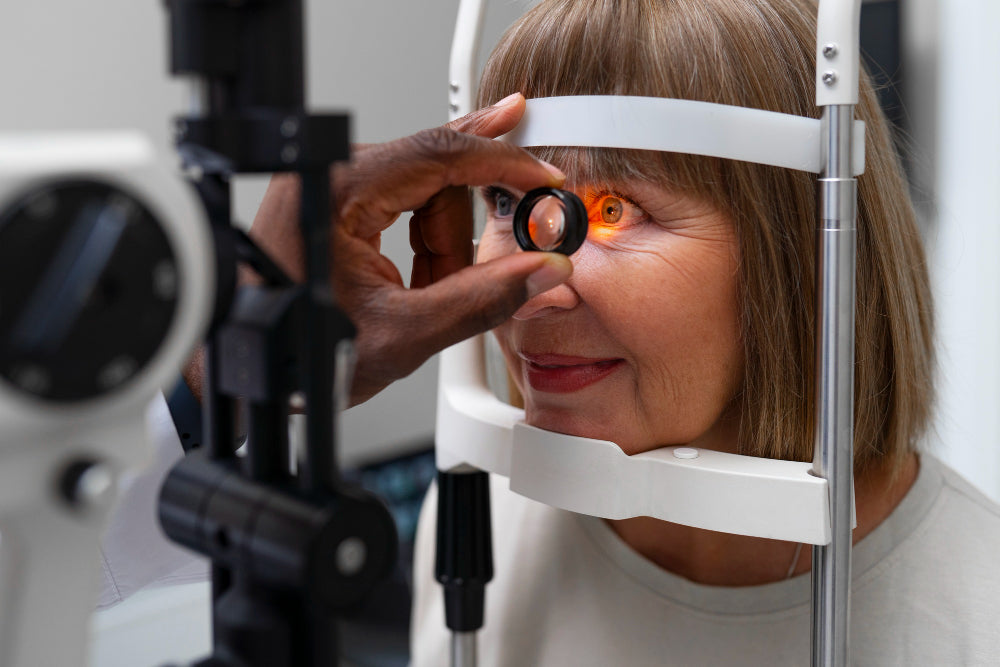Have you ever wondered about the differences between astigmatism and nearsightedness? These two common vision issues often need clarification, but understanding the distinctions is crucial for maintaining healthy eyes and getting the proper treatment.
Astigmatism blurs vision due to irregular cornea shape, affecting clarity at any distance. Nearsightedness primarily blurs distance vision while allowing clear near vision.
Differentiating between them hinges on understanding the nature of visual blurriness and specific symptoms.
In this blog post, we'll dive deep into astigmatism and nearsightedness, exploring their causes, symptoms, and how to manage them effectively.
What is Nearsightedness?

Nearsightedness, or myopia, is a refractive error where the eye can focus on close-up objects, but distant objects appear blurred.
It happens when the eyeball is longer than usual or the cornea is too curved, causing light to focus in front of the retina instead of directly on it.
Symptoms of Nearsightedness
Individuals with nearsightedness often experience:
- Difficulty seeing clearly at a distance, such as when driving or watching a movie
- Squinting or straining to see distant objects
- Headaches or eye strain while looking off in the distance
- The need to sit closer to the front of the classroom or the TV
Nearsightedness is a widespread condition, affecting an estimated 30-50% of the population in the United States. It typically develops in childhood and can progress throughout adolescence, making it crucial to monitor and manage.
What is Astigmatism?

Astigmatism is a refractive error that occurs when the cornea, the clear front part of the eye, is irregularly shaped. The cornea is more oval or football-shaped instead of having a perfectly spherical curve.
This irregular shape causes light to bend unevenly as it enters the eye, resulting in blurred or distorted vision at all distances. The word “astigmatism” comes from the Latin word “stigma”, meaning line. Thus when a person suffers from astigmatism, they see a “line” focus rather than a sharp point of focus when viewing objects.
Symptoms of Astigmatism
People with astigmatism often experience symptoms such as:
- Blurred or distorted vision, especially at night or in low-light conditions
- Difficulty seeing fine details or small print
- Headaches or eye strain after prolonged visual tasks
- Difficulty with vision both distance and near
Astigmatism is a common condition, affecting an estimated 30-60% of the population. It can occur with other refractive errors, such as nearsightedness or farsightedness, further complicating the visual experience.
Astigmatism vs. Nearsightedness: Spotting the Differences
How can you tell if you're dealing with astigmatism, nearsightedness, or perhaps a bit of both? Here are some key differences to help you distinguish between the two:
1. Blurry Vision Patterns
Nearsightedness typically causes blurry vision for objects in the distance, while astigmatism can blur vision at any distance and may cause distorted or wavy vision.
2. Eye Shape
Nearsightedness is primarily linked to the length or curvature of the eyeball, while astigmatism is more about the shape of the cornea or lens.
3. Symptoms
While both conditions can cause blurred vision, nearsightedness will manifest more prominently when looking at distant objects, whereas astigmatism may result in overall blurry or distorted vision regardless of distance.
4. Prescription
When you visit an eye care professional, they'll perform tests to determine your glasses or contact lenses prescription.
The prescription for correcting nearsightedness is focused on addressing the specific refractive error affecting distant vision, while astigmatism correction targets the irregular curvature of the cornea or lens.
Is Astigmatism the Same as Nearsightedness?
While astigmatism and nearsightedness are refractive errors, they are distinct conditions with different underlying causes and symptoms.
An irregularly shaped cornea causes astigmatism, while nearsightedness is caused by the eyeball being too long or the cornea being too curved.
It's important to note that astigmatism and nearsightedness can occur together, a condition known as compound myopic astigmatism. In this case, the individual experiences both blurred distance vision and distorted or blurred vision at all distances.
Seeking Solutions: Treating Astigmatism and Nearsightedness
Fortunately, both astigmatism and nearsightedness can be effectively managed through various treatment options. These include:
- Corrective lenses (eyeglasses or contact lenses) to help focus light correctly on the retina.
- Refractive surgery, such as LASIK or PRK, to reshape the cornea and improve visual acuity.
- Orthokeratology (Ortho-K), also known as CRT, or Corneal Refractive Therapy, is a non-surgical approach using specialized contact lenses to reshape the cornea while you sleep.
It's crucial to work closely with an eye care professional to determine the best treatment plan for your specific vision needs and to monitor changes over time.
By understanding the differences between astigmatism and nearsightedness, you can take proactive steps to maintain healthy vision and enjoy clear, comfortable sight at all distances.
Regular eye exams are essential for identifying and managing these common refractive errors.
Final Thoughts: Embracing Clarity
Whether you're grappling with nearsightedness, astigmatism, or a combination of both, understanding the differences between these common vision problems is the first step toward finding clarity.
If you're experiencing persistent blurry vision or other visual disturbances, don't hesitate to schedule an eye exam with a qualified eye care professional.
Remember, your eyesight is precious. So take care of it! Stay proactive about your eye health, and don't hesitate to seek professional guidance as needed. You can enjoy a world of clear, vibrant vision with the proper treatment and a dash of patience.
So, here's to seeing the world in all its vivid, unmistakable glory—no squinting required!





